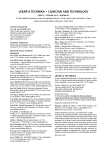MECHANICAL MODEL OF THE CARDIOVASCULAR SYSTEM: DETERMINATION OF CARDIAC OUTPUT BY DYE DILUTION
This paper deals with the experimental implementation of one of the methods for the determination of cardiac output – the dye dilution. Measurement is performed on a mechanical model of the cardiovascular system. It is a specific and experimental measurement intended mainly for educational purposes. It was created a real model of bloodstream at author’s workplace. The model enables to set a pulsatile flow of the fluid with defined pressure and flow rate. This experiment is to demonstrate the principle of determination of cardiac output using the dilution methods. This paper is focused only on measuring by dye dilution method. The measurement results are verified by using a Doppler sonography and volumetric containers.
Keywords:
cardiovascular system, cardiac output, dye dilution
Autoři:
Miroslav Ložek; Markéta Horálková; Jan Havlík
Působiště autorů:
Department of Circuit Theory, Czech Technical University in Prague, Czech Republic
Vyšlo v časopise:
Lékař a technika - Clinician and Technology No. 2, 2012, 42, 77-80
Kategorie:
Conference YBERC 2012
Souhrn
This paper deals with the experimental implementation of one of the methods for the determination of cardiac output – the dye dilution. Measurement is performed on a mechanical model of the cardiovascular system. It is a specific and experimental measurement intended mainly for educational purposes. It was created a real model of bloodstream at author’s workplace. The model enables to set a pulsatile flow of the fluid with defined pressure and flow rate. This experiment is to demonstrate the principle of determination of cardiac output using the dilution methods. This paper is focused only on measuring by dye dilution method. The measurement results are verified by using a Doppler sonography and volumetric containers.
Keywords:
cardiovascular system, cardiac output, dye dilution
Zdroje
[1] LOŽEK, M.: Model of the Cardiovascular System: Pump Control. In Proceedings of the 16th International Student Conference on Electrical Engineering Prague. 2012. ISBN 978-80-01-05043-9.
[2] LOŽEK, M. - HAVLÍK, J. - HORČÍK, Z.: Návrh mechanického modelu kardiovaskulárního systému : Sborník příspěvků, Letní doktorandské dny. Praha. 2012. ISBN: 978-80 - 01-05050-7.
[3] HAVRÁNEK, A.: Klasická mechanika II. Kontiuum. Karolinum, 2003. ISBN 80-246-0627-5.
[4] BATZEL, J. J. - KAPPEL, F. - SCHNEDITZ, D. - TRAN, H. T.: Cardiovascular and Respiratory Systems: Modeling, Analysis, and Control. 2006. ISBN 978-0898716177.
[5] WESTERHOF, N. - STERGIOPULOS, N. - NOBLE, M. I. M.: Snapshots of Hemodynamics. Basic Science for the Cardiologist, 2005.
[6] COBELLI, C. - CARSIN, E.: Introduction to modeling in physiology and medicine. Academic Press.2008. ISBN:978-0 - 12-160240-6.
[7] LE ROLLE, V. - HERNANDEZ, A. I. - RICHARD, P.Y. - BUISSON, J. - CARRAULT, G.: A Bond Graph Model of the Cardiovascular System. Acta Biotheorica, 2005.
Štítky
BiomedicínaČlánok vyšiel v časopise
Lékař a technika

2012 Číslo 2
Najčítanejšie v tomto čísle
- MECHANICAL MODEL OF THE CARDIOVASCULAR SYSTEM: DETERMINATION OF CARDIAC OUTPUT BY DYE DILUTION
- MATLAB AND ITS USE FOR PROCESSING OF THERMOGRAMS
- The Fifth Biomedical Engineering Conference of Young Biomedical Engineers and Researchers
- VALUATION METHODOLOGY FOR MEDICAL DEVICES
